When an organization decides to embrace Scrum, one of the first things to understand is how Scrum roles differ from traditional project execution roles. There are two sets of roles involved in Scrum:
Internal Role
- Product owner — holds the vision for the product
- Scrum Master — helps the team best use Scrum to build the product
- Development team — builds the product
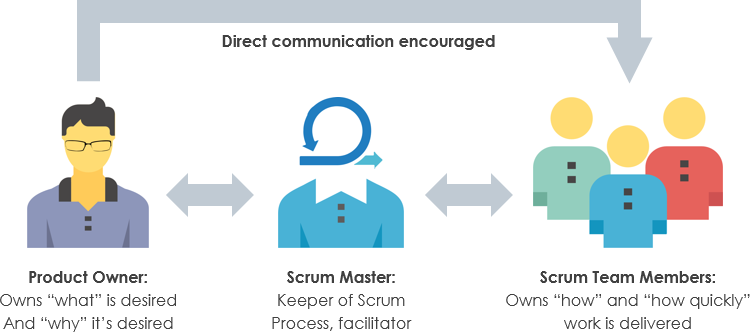
External Role
- Business Owner
- Stakeholder (i.e. end users and domain experts)
- etc.
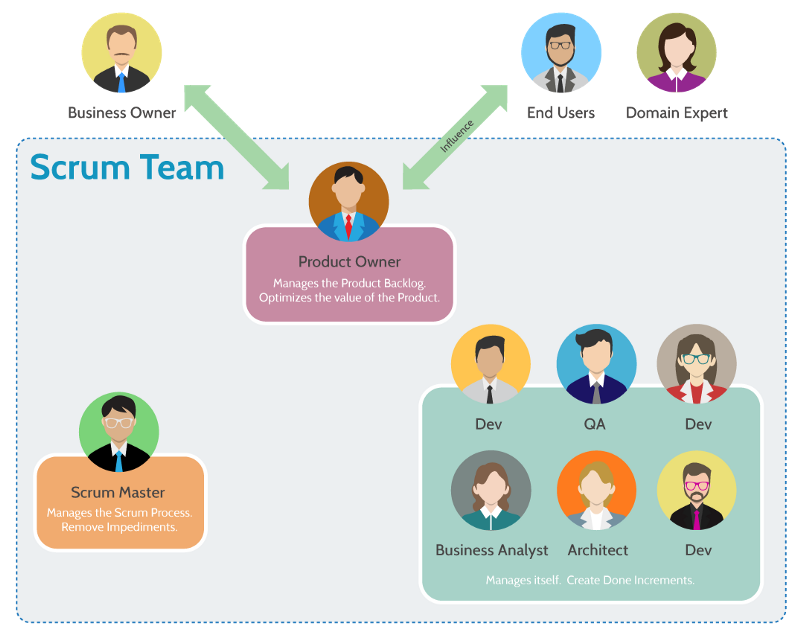
What is a Scrum Team?
A Scrum Team (commonly called the “Team”) is small (3 to 9 not including the Scrum Master and Product Owner), co-located (at least virtually), self-organized, self-contained, value-driven, full-time group of people called, simply, Team Members. Some of these terms need defining:
Self-Organized: A self-organized Team is one that chooses how best to accomplish its work, rather than being directed (micromanaged) by others outside the Team. Since the Team Members work together, this facilitates learning and motivates the Team to take ownership of its process.
Cross Functional: A cross-functional Team is one that contains all the knowledge and skills necessary to accomplish its objectives and goals, which allows it to finish its work without outside help.
Value-Driven: The Team Members value working together; they are constantly improving themselves, their Team, their environment, and their tools; and they strive to have personal values such as Openness, Focus, Commitment, Respect, and Courage.

Scrum Roles
Our journey begins with a general description of the Scrum Team itself, moves to a discussion of the three roles inside the Team (the Product Owner, the Scrum Master and the Development Team), and finishes with a description of roles outside the Team (the Business Owner, Stakeholders, and Subject Matter Experts).
Internal Roles
The Product Owner
Every member of the Scrum Team plays the role of Team Member, but only one Team Member is held accountable to the Business for the Scrum Team’s success and the value of the Scrum Team’s results. That’s the Product Owner or PO, for short. And that accountability is a big thing — it defines the PO as the formal leader of the Team as far as the outside world is concerned.
The Product Owner is the sole person responsible for managing the Product Backlog. Product Backlog management includes:
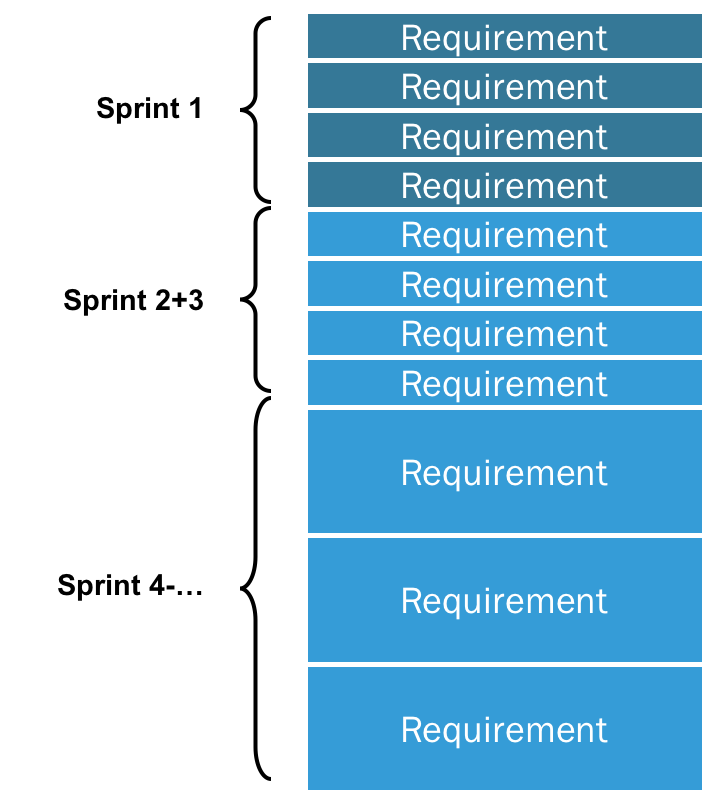
- Clearly expressing Product Backlog items.
- Ordering the items in the Product Backlog to best achieve goals and missions.
- Optimizing the value of the work the Development Team performs.
- Ensuring that the Product Backlog is visible, transparent, and clear to all, and shows what the Scrum Team will work on next.
- Ensuring the Development Team understands items in the Product Backlog to the level needed.
The PO is the Scrum Team’s eyes and ears to the outside world (to the Stakeholders). He or she is the Scrum Team’s one point of formal contact, the conduit of information. Add to this that the PO has the Scrum Team’s back. Meaning, in being held accountable for the Scrum Team’s results, the PO is consumed with making sure the Scrum Team is getting the right feedback to make the right Product at the right pace. The PO spends a lot of time scoping the Product, clarifying murky expectations, negotiating delivery dates, and making it all fit for the Scrum Team.
We should also note that even though the word ‘Owner’ is in the title, the PO may not be the Product expert. Granted, the PO has a whole lot of knowledge and skills, but the role is defined by the accountability, not by Product-specific skills. A good PO realizes there may be a wealth of smarts both inside and outside the Scrum Team and knows how to leverage this for both the Scrum Team’s good and the Product’s good.
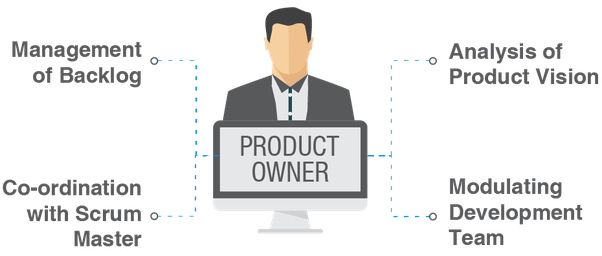
Scrum Master
The Scrum Master While the PO is the eyes and ears toward the outside world, in many ways, the Scrum Master’s eyes and ears are pointed decidedly inward which includes the following roles:
- The Scrum Master is an informal leader worried about what’s going on internally within the Scrum Team and making sure that Scrum is being used correctly.
- The Scrum Master is a leader without managerial responsibilities. Rather, he or she is laser focused on the health of the Scrum Team and the Scrum Team’s continuous improvement, especially when it comes to the Scrum Team’s use of Scrum.
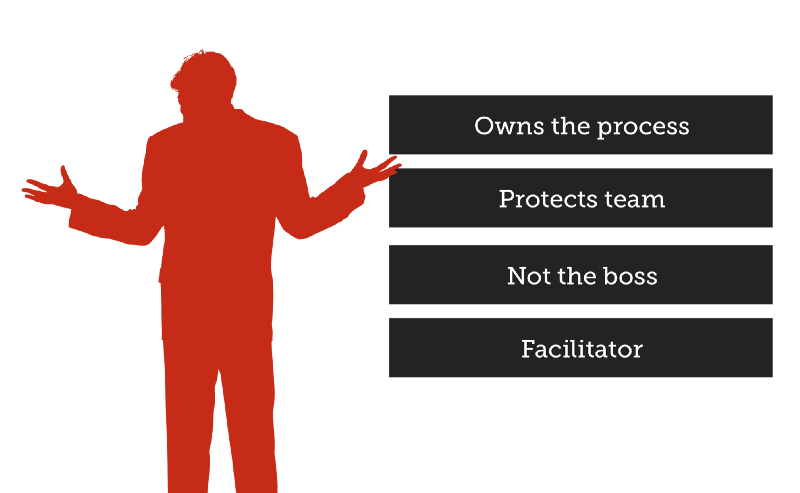
Roles a Scrum Master Plays
Service to the Product Owner
The Scrum Master serves the Product Owner in several ways, including:
- Ensuring that goals, scope, and product domain are understood by everyone on the Scrum Team as well as possible.
- Finding techniques for effective Product Backlog management.
- Helping the Scrum Team understand the need for clear and concise Product Backlog items.
- Understanding product planning in an empirical environment.
- Ensuring the Product Owner knows how to arrange the Product Backlog to maximize value.
- Understanding and practicing agility.
- Facilitating Scrum events as requested or needed.
Scrum Master Service to the Development Team
The Scrum Master serves the Development Team in several ways, including:
- Coaching the Development Team in self-organization and cross-functionality.
- Helping the Development Team to create high-value products.
- Removing impediments to the Development Team’s progress.
- Facilitating Scrum events as requested or needed.
- Coaching the Development Team in organizational environments in which Scrum is not yet fully adopted and understood.
Scrum Master Service to the Organization
The Scrum Master serves the organization in several ways, including:
- Leading and coaching the organization in its Scrum adoption;
- Planning Scrum implementations within the organization;
- Helping employees and stakeholders understand and enact Scrum and empirical product development;
- Causing change that increases the productivity of the Scrum Team; and,
- Working with other Scrum Masters to increase the effectiveness of the application of Scrum in the organization.
Development Team
The Development Team The term “Development Team” is used to represent the portion of the Scrum Team that is currently developing or creating the Product — and this may, or may not, include the PO and SM. It is entirely proper, and often useful, for the PO and SM to be on the Development Team, but they must always realize that their leadership roles come first.
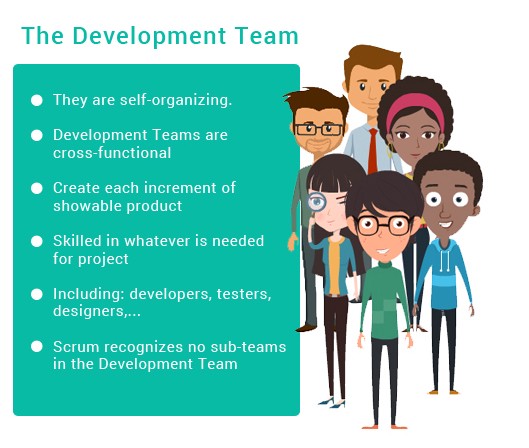
External Roles
Stakeholders are the purpose for which a Product or service is created in the first place. Stakeholders are the people who have certain necessities, wants and desires; thus in business terms they have certain requirements which needs to be fulfilled.
Scrum defines stakeholders as not part of the Scrum-team. It is the responsibility of the Scrum Team to fulfill the requirements of the Stakeholders and satisfy them.
Note that:
Usually stakeholders do not have clear understanding of what they need and even if they do they keep changing their minds very often. Usually figuring out the actual needs of a stakeholder is achieved through a lot of meetings with the stakeholders and also after a lot of trial and error.
Other Essential Articles Related to Scrum Roles:
- What is Scrum Team?
- What is a Self-Organizing Team in Scrum?
- How Scrum Team Works? — A Brief Guide
- How to be a Good Product Owner in Scrum Project?
- What is Product Owner’s Role in Scrum?
- Agile Development: How to Become a Qualified Scrum Master?
- What is Pig and Chicken in Scrum?
- Project Manager vs Scrum Master vs Project Owner
- What Are The Three Scrum Roles?
- What is a Scrum Master? The Role and Responsibilities
- What is Cross-Functional Team in Agile?

